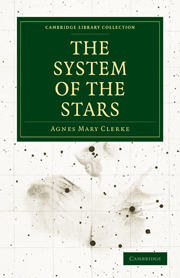Book contents
- Frontmatter
- PREFACE
- Contents
- ILLUSTRATIONS
- ADDENDA
- CHAPTER I THE TASK OF SIDEREAL ASTRONOMY
- CHAPTER II THE METHODS OF SIDEREAL RESEARCH
- CHAPTER III SIRIAN AND SOLAR STARS
- CHAPTER IV STARS WITH BANDED SPECTRA
- CHAPTER V GASEOUS STARS AND NEBULÆ
- CHAPTER VI SIDEREAL EVOLUTION
- CHAPTER VII TEMPORARY STARS
- CHAPTER VIII VARIABLE STARS OF LONG PERIOD
- CHAPTER IX VARIABLE STARS OF SHORT PERIOD
- CHAPTER X THE COLOURS OF THE STARS
- CHAPTER XI DOUBLE STARS
- CHAPTER XII VARIABLE DOUBLE STARS
- CHAPTER XIII STELLAR ORBITS
- CHAPTER XIV MULTIPLE STARS
- CHAPTER XV THE PLEIADES
- CHAPTER XVI STAR CLUSTERS
- CHAPTER XVII THE FORMS OF NEBULÆ
- CHAPTER XVIII THE GREAT NEBULÆ
- CHAPTER XIX THE NATURE AND CHANGES OF NEBULÆ
- CHAPTER XX THE DISTANCES OF THE STARS
- CHAPTER XXI TRANSLATION OF THE SOLAR SYSTEM
- CHAPTER XXII THE PROPER MOTIONS OF THE STARS
- CHAPTER XXIII THE MILKY WAY
- CHAPTER XXIV STATUS OF THE NEBULÆ
- CHAPTER XXV THE CONSTRUCTION OF THE HEAVENS
- APPENDIX.—TABLES OF STELLAR DATA
- INDEX
- Plate section
CHAPTER XVIII - THE GREAT NEBULÆ
Published online by Cambridge University Press: 05 July 2011
- Frontmatter
- PREFACE
- Contents
- ILLUSTRATIONS
- ADDENDA
- CHAPTER I THE TASK OF SIDEREAL ASTRONOMY
- CHAPTER II THE METHODS OF SIDEREAL RESEARCH
- CHAPTER III SIRIAN AND SOLAR STARS
- CHAPTER IV STARS WITH BANDED SPECTRA
- CHAPTER V GASEOUS STARS AND NEBULÆ
- CHAPTER VI SIDEREAL EVOLUTION
- CHAPTER VII TEMPORARY STARS
- CHAPTER VIII VARIABLE STARS OF LONG PERIOD
- CHAPTER IX VARIABLE STARS OF SHORT PERIOD
- CHAPTER X THE COLOURS OF THE STARS
- CHAPTER XI DOUBLE STARS
- CHAPTER XII VARIABLE DOUBLE STARS
- CHAPTER XIII STELLAR ORBITS
- CHAPTER XIV MULTIPLE STARS
- CHAPTER XV THE PLEIADES
- CHAPTER XVI STAR CLUSTERS
- CHAPTER XVII THE FORMS OF NEBULÆ
- CHAPTER XVIII THE GREAT NEBULÆ
- CHAPTER XIX THE NATURE AND CHANGES OF NEBULÆ
- CHAPTER XX THE DISTANCES OF THE STARS
- CHAPTER XXI TRANSLATION OF THE SOLAR SYSTEM
- CHAPTER XXII THE PROPER MOTIONS OF THE STARS
- CHAPTER XXIII THE MILKY WAY
- CHAPTER XXIV STATUS OF THE NEBULÆ
- CHAPTER XXV THE CONSTRUCTION OF THE HEAVENS
- APPENDIX.—TABLES OF STELLAR DATA
- INDEX
- Plate section
Summary
The elliptical and irregular classes of nebulæ are illustrated by such splendid examples that we have thought it well to devote a chapter to their separate consideration. One member especially of each towers above the rest, like Ajax among the Argive host, its rival alone excepted, and the two are so different that it is not easy to award the palm of superiority to either. Needless to say that we allude to the objects in Andromeda and Orion, the types respectively of the elliptical and irregular plans of nebular construction.
The former (M 31) is the only real nebula which can readily be detected with the unaided eye, and it is the only one, accordingly, which was discovered in pre-telescopic times. Al Sûfi was familiar with the ‘little cloud’ near the most northern of the three stars in the girdle of Andromeda; and its place was marked on a star-map brought from Holland to Paris by De Thou, and believed to date from the tenth century. Simon Marius, who was the first to turn a telescope upon it, December 15, 1612, called it ‘stellam quandam admirandæ figuræ,’ and compared its dull and pallid rays to those of a candle shining by night through a semi-transparent piece of horn. Yet this strange phenomenon was only rescued from neglect by Boulliaud, whose attention was directed to it by the passage of the comet of 1664 across that part of the sky.
- Type
- Chapter
- Information
- The System of the Stars , pp. 268 - 284Publisher: Cambridge University PressPrint publication year: 2010First published in: 1890



